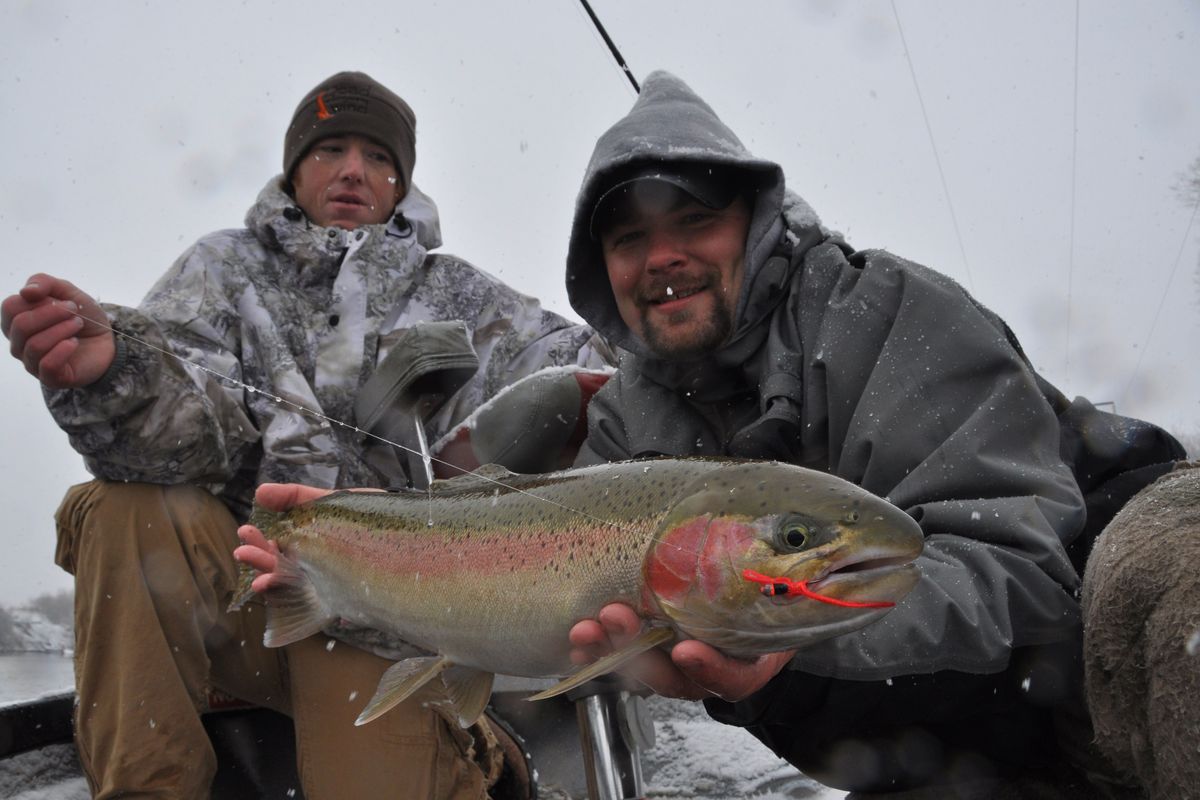Okanogan Valley Guide Services caters to fishermen in any weather

People who wait for perfect weather miss a lot of good fishing,” said Jerrod Gibbons, blowing warm breath on his numb fingers Tuesday after releasing a bright, fat steelhead in the Okanogan River.
A storm had moved in that morning, covering his boat and gear with snow, but the steelhead and Gibbons were unaffected.
“March is when the fish really start moving into the river and the fishing can be great right through the end of the month when the season closes,” he said.
Gibbons should know. The 30-year-old runs his business, Okanogan Valley Guide Service ( okanoganvalleyguideservice.com), the same way he operated as a sportsman growing up in Omak – year-round.
“I work with about 10 guides, all locals who grew up in this area and know how the fish and game moves with the seasons,” he said. “And we have access to the water and a lot of the private land.”
He learned the Okanogan River’s structure fishing for its smallmouth bass. Meantime, he learned where it holds steelhead, a fishery that’s vastly improved since he was a kid.
He’ll take a break at The Big Horn Outdoor Recreation Show in Spokane Thursday-Sunday to share his schedule in a rare spot on the globe that offers premier hunting or fishing experiences every month of the year.
Here’s how he describes his schedule and his blessings in a nutshell:
• March – Focus on steelhead in the Columbia and especially the fish heading into the Okanogan River.
• April – Wild turkey hunting season is perfectly timed for the lull before salmon arrive.
• Mid-May through June – Key on spring chinook salmon, especially in the sweet flows of the Icicle River.
• July through mid-August – “We’ll be in flip-flops and shorts on the Columbia harvesting summer chinook as bright, firm and delicious as you’ll find on any river.”
• Early September through early October – Fall chinook pack into the upper Columbia.
• Mid-October – “I race home from the Columbia because it’s deer season!” he said. “My guides have been out for the early muzzleloader hunt while I’m fishing and they have it all scouted out. I just join in.”
• November – “I divvy up my time with goose, duck and upland bird hunting, also archery deer, with a lot of clients wanting to do cast-and-blast trips to mix hunting with steelheading.”
• December through March – “I’m back mostly to steelheading. When the Okanogan River freezes in December, I’ll move into the Columbia. But when the ice comes out in March, I’m back to finish the season in the Okanogan because the steelhead are trucking up the river.”
Indeed, on Tuesday he was using an orange quarter-ounce jig under a bobber to hook several steelhead in the lower river.
The first fish hooked – a hatchery hen that measured 27.5 inches long – leaped completely out of the water four times during the battle to the boat despite the cold water with ice chunks floating downstream.
“These steelhead stay down to fight when they’re in the Columbia, but once they head up the Okanogan they seem to hit another gear,” Gibbons said.
Moments later, he hooked and released a wild hen steelhead that was another third larger.
The lower Okanogan, where private land largely restricts shore access, is fished best from a jet sled. The water gets skinny in areas, especially when hydropower managers suddenly dump water through Wells Dam downstream on the Columbia.
“There are some nasty submerged boulders on this lower river in areas where it otherwise looks like a deep reservoir,” he said.
“The Okanogan has a lot of calm water, dead water,” he said. “You have to be looking for holes and seams even in the areas that look like a lake at some flows.”
In certain conditions, he prefers fishing his drift boat farther upstream to hit the 13 definable holes and other niches between Omak and Okanogan.
“I don’t fish the Methow River very much simply because I don’t have to,” he said. “It’s a good river with more frequent holes, but there are lots of fishermen there. I can fish the Okanogan and be alone.”